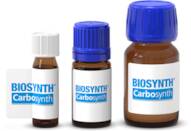1,1'-Di-N-heptyl-4,4'-bipyridium dibromide
CAS : 6159-05-3
Ref. 3D-FD16285
| 1g | Arrêté | ||
| 2g | Arrêté | ||
| 5g | Arrêté | ||
| 10g | Arrêté | ||
| 25g | Arrêté |
Informations sur le produit
- 1,1'-Diheptyl-4,4'-bipyridinium
- 1,1′-Di-N-heptyl-4,4′-dipyridinium dibromide
- 1,1′-Diheptyl-4,4′-bipyridinium dibromide
- 4,4'-Bipyridinium, 1,1'-diheptyl-, dibromide
- Diheptylviologen bromide
- Diheptylviologen dibromide
- Heptylviologen bromide
- Heptylviologen dibromide
- N,N′-Diheptyl-4,4′-bipyridinium dibromide
- N,N′-Diheptyl-4,4′-dipyridinium dibromide
- Voir d'autres synonymes
- N,N′-Diheptyl-4,4′-dipyridylium dibromide
- 4,4′-Bipyridinium, 1,1′-diheptyl-, bromide (1:2)
- 4,4'-Bipyridinium, 1,1'-diheptyl-, bromide (1:2)
1,1'-Di-N-heptyl-4,4'-bipyridium dibromide is a fluorescent dye that binds to ryanodine receptor. Ryanodine receptors are calcium channels in muscle cells that regulate the release of calcium ions from the sarcoplasmic reticulum (SR). The binding of 1,1'-Di-N-heptyl-4,4'-bipyridium dibromide to ryanodine receptor can be visualized by fluorescence microscopy. Ryanodine receptor is found in the brain and its expression level influences Alzheimer's disease progression. 1,1'-Di-N-heptyl-4,4'-bipyridium dibromide has been shown to inhibit proliferation of cancer cells in vitro. It also reversibly inhibits the uptake of calcium ions into SR. This compound could be used as a potential drug for cancer treatment if it is able to inhibit SR uptake without affecting other





